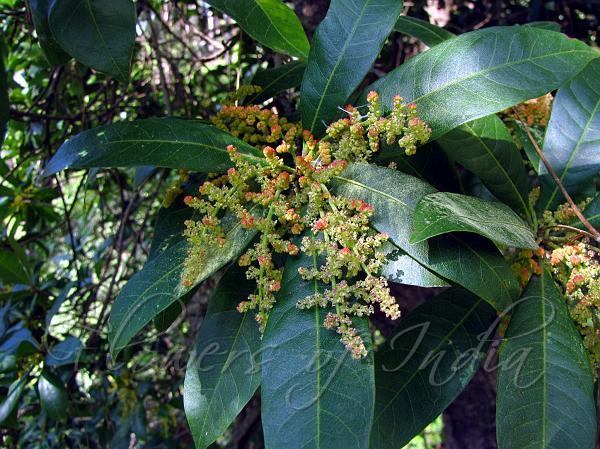|
| Himalayan Bayberry |
|

|

| File size | 795955 |
| Original date | 9/28/12 3:25 PM |
| Resolution | 2048 x 1536 |
| Flash | Flash did not fire, auto |
| Focal length | 5.0mm |
| Exposure time | 1/60s |
| Aperture | 4.0 |
| Focus Distance | |
| Metering Mode | Multi-segment |
| Camera make | Canon |
| Camera model | Canon PowerShot SX10 IS |
| Sensor type | OneChipColorArea |
|
|
|
|
Photo: |
Botanical name: Myrica esculenta Family: Myricaceae (Bayberry family)
Synonyms: Myrica sapida, Morella esculenta
Synonyms: Myrica sapida, Morella esculenta
Himalayan bayberry is a tree of medium height, 20-25 feet.
Leaf-stalk 0.3-2 cm, velvet-hairy to woolly; leaf blade narrowly
elliptic-obovate or lanceshaped-obovate to wedge-shaped-obovate, 4-18 ×
1.5-4.5 cm, leathery, below pale green, dark dotted, occasionally sparsely
golden glandular, above dark green, rarely glandular, velvet-hairy
along midvein, base wedge-shaped, margin entire or sometimes sawtoothed
in apical 1/2, tip blunt to pointed. Female flowers are very small,
stalkless, solitary and bracteate, sepals and petals, either absent or
not visible. Inflorescence is a catkin, 4.2 cm long, in leaf-axils,
bearing about 25 flowers; only a thread-like style visible with the
unaided eye. Each male flower has about 12 stamens, each with a very
short filament; inflorescence is a compound raceme, about 3.5 cm long.
The fruits are 1.1-1.3 cm round and reddish-purple
when ripe. They have a sweet-tart flavor and are consumed fresh or
processed into juices, jams, and other products. Himalayan bayberry is
globally distributed across Indo-Malesian region. Within India, it has
been recorded in Jammu & Kashmir, Himachal Pradesh, Uttar Pradesh,
Sikkim, Arunachal Pradesh, Assam, Meghalaya, Nagaland, Manipur and
Mizoram between an altitude range of 1000-2300 m.
Medicinal uses:  Himalayan bayberry is used in traditional medicine for a wide range of
ailments, including respiratory issues like asthma and chronic bronchitis,
as well as digestive problems such as diarrhea and stomach ulcers. Other
traditional uses include treating fever, inflammation, skin sores,
and urinary complaints.
Himalayan bayberry is used in traditional medicine for a wide range of
ailments, including respiratory issues like asthma and chronic bronchitis,
as well as digestive problems such as diarrhea and stomach ulcers. Other
traditional uses include treating fever, inflammation, skin sores,
and urinary complaints.
 Himalayan bayberry is used in traditional medicine for a wide range of
ailments, including respiratory issues like asthma and chronic bronchitis,
as well as digestive problems such as diarrhea and stomach ulcers. Other
traditional uses include treating fever, inflammation, skin sores,
and urinary complaints.
Himalayan bayberry is used in traditional medicine for a wide range of
ailments, including respiratory issues like asthma and chronic bronchitis,
as well as digestive problems such as diarrhea and stomach ulcers. Other
traditional uses include treating fever, inflammation, skin sores,
and urinary complaints.| Identification credit: Amit Kumar | Photographed in Mussoorie Forest division,Mussoorie, Uttarakhand. |
• Is this flower misidentified? If yes,